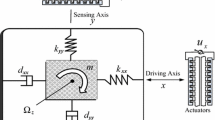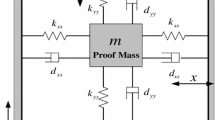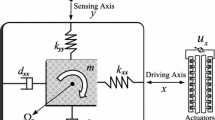Abstract
A novel adaptive dynamic surface control (DSC) method for the micro-electromechanical systems gyroscope, which combined the approaches of a radial basis function neural networks (RBFNN) and a nonsingular terminal sliding mode (NTSM) controller was proposed in this paper. In the DSC, a first-order filter was introduced to the conventional adaptive backstepping technique, which not only maintains the advantage of original backstepping technique, but also reduces the number of parameters and avoids the problem of parameters expansion. The RBFNN is an approximation to the gyroscope’s dynamic characteristics and external disturbances. By introducing a nonsingular terminal sliding mode controller which ensuring the control system could reach the sliding surface and converge to equilibrium point in a finite period of time from any initial state. Finally, simulation results prove that the proposed approach could reduce the chattering of inputs, improve the timeliness and effectiveness of tracking in the presence of model uncertainties and external disturbances, demonstrating the excellent performance compared to nonsingular terminal sliding mode control (NTSMC).







Similar content being viewed by others
References
Liu Z, Aduba C, Won C (2011) In-plane dead reckoning with knee and waist attached gyroscopes. Measurement 10(6):1860–1868
Tsai NC, Sue CY (2010) Experimental analysis and characterization of electrostatic-drive tri-axis micro-gyroscope. Sens Actuators A 2(3):231–239
Yazdi N, Ayazi F (1998) Micromachined inertial sensors. Proc IEEE 86(7):1640–1659
Leland R (2003) Adaptive mode tuning for vibrational gyroscopes. IEEE Trans Control Syst Technol 11(2):242–247
Dong L (2005) The adaptive control system of a MEMS gyroscope with time-varying rotation rate. In: Proceedings of American Control Conference, vol 7, Issue 2, pp 3592–3597
Park S, Horowitz R (2001) Adaptive control for Z-axis MEMS gyroscopes. In: Proceedings of American Control Conference, vol 10, Issue 2, pp 1223–12281
Fei J, Yang Y (2012) Comparative study of system identification approaches for adaptive tracking of MEMS gyroscope. Int J Robot Autom 27(30):322–329
Wang C, Yau H (2011) Nonlinear dynamic analysis and sliding mode control for a gyroscope system. Nonlinear Dyn 66(1):53–65
Lin S, Chen Y (1994) RBF network based sliding mode control. IEEE Trans Syst Man Cybern 5(4):1957–1961
Lewis FL, Jagannathan S, Yesildirek A (1999) Neural network control of robot manipulators. IEEE Expert 11(3):64–75
Feng G (1995) A compensating scheme for robot tracking based on neural networks. Robot Auton Syst 15(4):199–206
Fei J, Ding H (2014) Robust adaptive neural sliding mode control of MEMS triaxial gyroscope with angular velocity estimation. Neural Comput Appl 24(1):201–210
Yan W, Fei J, Yang Y (2013) Adaptive global fast terminal sliding mode control of MEMS gyroscope. In: Proceedings of 2013 32nd Chinese Control Conference, pp 3135–3140
Li S, Zhou M, Yu XH (2013) Design and implementation of terminal sliding mode control method for PMSM speed regulation system. IEEE Trans Ind Inform 9(4):1879–1891
Feng Y, Yu XH, Han FL (2013) On nonsingular terminal sliding-mode control of nonlinear systems. Automatica 49:1715–1722
Yip PP, Hedrick JK (1998) Adaptive dynamic surface control: a simplified algorithm for adaptive backstepping control of nonlinear systems. Int J Control 71(5):959–979
Waroop D, Hedrick JK, Yip PP (2000) Dynamic surface control for a class of nonlinear systems. IEEE Trans Autom Control 45(10):1893–1899
Zhang TP, Ge SS (2008) Adaptive dynamic surface control of nonlinear systems with unknown dead zone in pure feedback form. Automatica 44(7):1895–1903
Li TS, Wang D, Feng G, Tong SC (2010) A DSC approach to robust adaptive NN tracking control for strict-feedback nonlinear systems. IEEE Trans Syst Man Cybern Part B Cybern 40(3):915–927
Pan Y, Yu H (2015) Dynamic surface control via singular perturbation analysis. Automatica 57:29–33
Chen WS (2009) Adaptive backstepping dynamic surface control for systems with periodic disturbances using neural networks. IET Control Theory Appl 3(10):1383–1394
Li Y, Tong S, Li T (2015) Adaptive fuzzy output feedback dynamic surface control of interconnected nonlinear pure-feedback systems. IEEE Trans Cybern 45(1):138–149
Wang D, Huang J (2005) Neural network-based adaptive dynamic surface control for a class of uncertain nonlinear systems in strict feedback form. IEEE Trans Neural Netw 16(1):195–202
Pan Y, Yu H (2015) Composite learning from adaptive dynamic surface control. IEEE Trans Autom Control 61:2603–2609
Li Y, Tong S (2015) Prescribed performance adaptive fuzzy output-feedback dynamic surface control for nonlinear large-scale systems with time delays. Inf Sci 292:125–142
Yoo SJ, Park JB, Choi YH (2006) Adaptive dynamic surface control of flexible-joint robots using self-recurrent wavelet neural networks. IEEE Trans Syst Man Cybern Part B Cybern 36(6):1342–1355
Song ZK, Li HX, Sun KB (2014) Adaptive dynamic surface control for MEMS triaxial gyroscope with nonlinear inputs. Nonlinear Dyn 78(1):173–182
Acknowledgements
The authors thank the anonymous reviewers for their useful comments that improved the quality of the paper. This work is partially supported by National Science Foundation of China under Grant No. 61374100; The Fundamental Research Funds for the Central Universities under Grant No. 2014B05014.
Author information
Authors and Affiliations
Corresponding author
Rights and permissions
About this article
Cite this article
Lei, D., Fei, J. Adaptive neural nonsingular terminal sliding mode control for MEMS gyroscope based on dynamic surface controller. Int. J. Mach. Learn. & Cyber. 9, 1285–1295 (2018). https://doi.org/10.1007/s13042-017-0643-2
Received:
Accepted:
Published:
Issue Date:
DOI: https://doi.org/10.1007/s13042-017-0643-2




